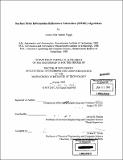| dc.contributor.advisor | David H. Staelin. | en_US |
| dc.contributor.author | Viggh, Herbert E. M | en_US |
| dc.contributor.other | Massachusetts Institute of Technology. Dept. of Electrical Engineering and Computer Science. | en_US |
| dc.date.accessioned | 2005-06-02T16:12:05Z | |
| dc.date.available | 2005-06-02T16:12:05Z | |
| dc.date.copyright | 2001 | en_US |
| dc.date.issued | 2001 | en_US |
| dc.identifier.uri | http://hdl.handle.net/1721.1/17564 | |
| dc.description | Thesis (Ph. D.)--Massachusetts Institute of Technology, Dept. of Electrical Engineering and Computer Science, 2001. | en_US |
| dc.description | Includes bibliographical references (p. 393-396). | en_US |
| dc.description.abstract | In this thesis we address the problem of estimating changes in surface reflectance in hyperspectral image cubes, under unknown multiplicative and additive illumination noise. Rather than using the Empirical Line Method (ELM) or physics-based approaches, we assumed the presence of a prior reflectance image cube and ensembles of typical multiplicative and additive illumination noise vectors, and developed algorithms which estimate reflectance using this prior information. These algorithms were developed under the additional assumptions that the illumination effects were band limited to lower spatial frequencies and that the differences in the surface reflectance from the prior were small in area relative to the scene, and have defined edges. These new algorithms were named Surface Prior Information Reflectance Estimation (SPIRE) algorithms. Spatial SPIRE algorithms that employ spatial processing were developed for six cases defined by the presence or absence of the additive noise, and by whether or not the noise signals are spatially uniform or varying. These algorithms use high-pass spatial filtering to remove the noise effects. Spectral SPIRE algorithms that employ spectral processing were developed and use zero-padded Principal Components (PC) filtering to remove the illumination noise. Combined SPIRE algorithms that use both spatial and spectral processing were also developed. A Selective SPIRE technique that chooses between Combined and Spectral SPIRE reflectance estimates was developed; it maximizes estimation performance on both modified and unmodified pixels. The different SPIRE algorithms were tested on HYDICE airborne sensor hyperspectral data, and their reflectance estimates were compared to those from the physics-based ATmospheric REMoval (ATREM) and the Empirical Line Method atmospheric compensation algorithms. SPIRE algorithm performance was found to be nearly identical to the ELM ground-truth based results. SPIRE algorithms performed better than ATREM overall, and significantly better under high clouds and haze. Minimum-distance classification experiments demonstrated SPIRE's superior performance over both ATREM and ELM in cross-image supervised classification applications. The taxonomy of SPIRE algorithms was presented and suggestions were made concerning which SPIRE algorithm is recommended for various applications. | en_US |
| dc.description.statementofresponsibility | by Herbert Erik Mattias Viggh. | en_US |
| dc.format.extent | 396 p. | en_US |
| dc.format.extent | 16115334 bytes | |
| dc.format.extent | 29202860 bytes | |
| dc.format.mimetype | application/pdf | |
| dc.format.mimetype | application/pdf | |
| dc.language.iso | eng | en_US |
| dc.publisher | Massachusetts Institute of Technology | en_US |
| dc.rights | M.I.T. theses are protected by copyright. They may be viewed from this source for any purpose, but reproduction or distribution in any format is prohibited without written permission. See provided URL for inquiries about permission. | en_US |
| dc.rights.uri | http://dspace.mit.edu/handle/1721.1/7582 | |
| dc.subject | Electrical Engineering and Computer Science. | en_US |
| dc.title | Surface Prior Information Reflectance Estimation (SPIRE) algorithms | en_US |
| dc.title.alternative | SPIRE algorithms | en_US |
| dc.type | Thesis | en_US |
| dc.description.degree | Ph.D. | en_US |
| dc.contributor.department | Massachusetts Institute of Technology. Department of Electrical Engineering and Computer Science | |
| dc.identifier.oclc | 52384737 | en_US |
